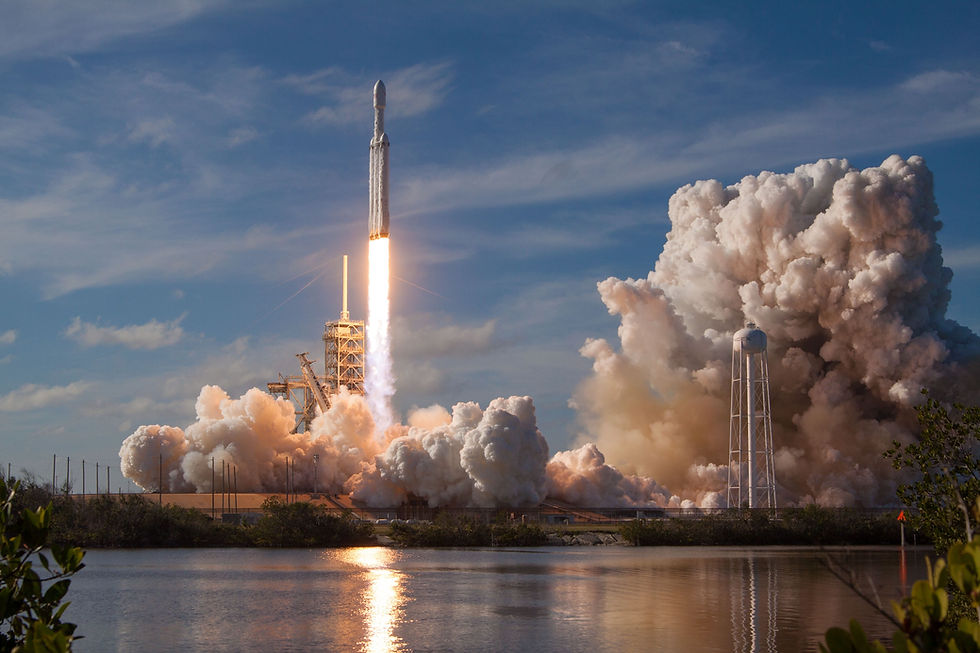Fundamental Rocket Mechanics
- Amanda Grodman

- Jul 12, 2023
- 3 min read
Understanding methods of maximizing a space mission–whether it be in the design, materials, or function of a spacecraft–is a critical part of an aerospace engineer’s job. However, it is equally important to recognize the fundamental concepts that allow spacecrafts to launch in the first place. Rockets have historically stood around several hundred feet and weighed millions of pounds, when considering the payload, fuel, and crew modules involved. Their purposes can widely vary; current NASA projects involve several stages of missions that may or may not be crewed, and rather try to test trajectories for future missions, while other stages hope to bring passengers to the Moon. Despite these differences, several critical features define the anatomy of a functional rocket–with more improvements on the way. With the ongoing Artemis mission, and sure continuous use of rockets, improving their designs and techniques is critical in further promoting space exploration.

Possibly the most notable component of the rocket’s design is the propulsion system, which consists of the engines, pumps, and nozzle. As NASA describes, propellants are a mixture of oxygen and fuel that are mixed (either when the rocket is scheduled to liftoff or before this time) and combust within a chamber. The exhaust from this chemical reaction causes thrust, which effectively accelerates the rocket off of the ground via the engines' exhaust. Most of the rocket's staggering weight is composed of the propulsion system and its accessories. While the propulsion system is an essential part of the rocket launch, other designs of this projectile–and of many other spacecraft–allow a mission to run smoothly. The structural system acts as the outer coating and “frame” (per NASA) of the rocket, while the guidance system includes computers and sensors to direct the rocket’s movements. Rocket boosters, such as those seen on Artemis’ SLS, can be seen on the sides and add additional support to spacecraft that carry larger payloads (including its several modules), and the common image of these detaching from a rocket once in orbit is because they lack fuel from consumption (i.e., the projectile gets rid of excess weight).

Recent research on rockets has aimed to make the launching and exploration process more efficient and productive for space-goers; given the possibility of more people visiting space within the next few years, such studies are surely needed. For example, studies have increased trajectory accuracy to avoid asteroids using computational techniques (D’Ambrosio, 2023), improved aircraft frame designs (Yuki, 2022), and carefully maneuvered “descent and landing” methods for improved safety (Vitiello, 2023). Of course, rockets aren’t the only component of space exploration, but provide useful knowledge when getting rovers and helicopters onto another planet. Rovers have a similar design to rockets (despite having a different appearance), including the outer covering (like the rocket’s frame), inner electronics (like the guidance system), and wheels (which power the rover forward, as do the rocket’s engines). Moreover, Ingenuity (or the "Mars Helicopter") showed possibilities of extraterrestrial travel and movement by completing a self-sustained flight on the Red Planet. Several components of a rocket’s anatomy and mechanics parallel those of helicopters–which play a critical role in pioneering discoveries in space.

In this episode of “Let’s Go to Space: BLUESKY Learning,” Episode 119: A Sikorsky Woman in STEM, we’re joined with Rachel Garza, a NASA veteran and current propulsion flight test engineer at Lockheed Martin’s Sikorsky. At NASA, Ms. Garza worked as an astronaut instructor for the ISS and flight controller in the Mission Control Center. She has also earned other impressive positions in systems engineering, and has always wanted to maintain a close relationship to the space field. Ms. Garza shares her insightful, nonlinear path to her current position at Sikorsky–and reminds younger space advocates to never lose sight of their true aspirations. Learn more about Rachel Garza, or visit our other weekly podcasts to hear from other speakers, by clicking the link above. Also make sure to check out our website to learn more about becoming a member of the Aerospace and Innovation Academy, where you can join us in our quest to go to space.




Comments